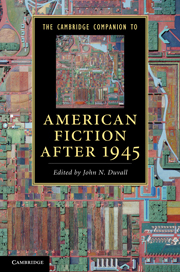26 results
Chapter 4 - Faulkner and Print Culture
- from Part I - Approaches
-
-
- Book:
- The New William Faulkner Studies
- Published online:
- 23 June 2022
- Print publication:
- 07 July 2022, pp 67-83
-
- Chapter
- Export citation
Chapter 8 - Historical Fiction
- from Part II - Forms
-
-
- Book:
- American Literature in Transition, 1990–2000
- Published online:
- 11 December 2017
- Print publication:
- 28 December 2017, pp 124-139
-
- Chapter
- Export citation
Chapter 7 - Appropriate Appropriation?
- from Part Two - Race and Performativity
-
-
- Book:
- Postmodern Literature and Race
- Published online:
- 05 February 2015
- Print publication:
- 19 February 2015, pp 113-126
-
- Chapter
- Export citation
Notes on Contributors
-
-
- Book:
- Postmodern Literature and Race
- Published online:
- 05 February 2015
- Print publication:
- 19 February 2015, pp vii-xii
-
- Chapter
- Export citation
PART II - HISTORICAL AND CULTURAL CONTEXTS
-
- Book:
- The Cambridge Companion to American Fiction after 1945
- Published online:
- 28 March 2012
- Print publication:
- 08 December 2011, pp -
-
- Chapter
- Export citation

The Cambridge Companion to American Fiction after 1945
-
- Published online:
- 28 March 2012
- Print publication:
- 08 December 2011
Introduction: A story of the stories of American fiction after 1945
-
-
- Book:
- The Cambridge Companion to American Fiction after 1945
- Published online:
- 28 March 2012
- Print publication:
- 08 December 2011, pp 1-12
-
- Chapter
- Export citation
PART III - MAJOR AUTHORS
-
- Book:
- The Cambridge Companion to American Fiction after 1945
- Published online:
- 28 March 2012
- Print publication:
- 08 December 2011, pp -
-
- Chapter
- Export citation
Index
-
- Book:
- The Cambridge Companion to American Fiction after 1945
- Published online:
- 28 March 2012
- Print publication:
- 08 December 2011, pp 265-271
-
- Chapter
- Export citation
Cambridge Companions to …
-
- Book:
- The Cambridge Companion to American Fiction after 1945
- Published online:
- 28 March 2012
- Print publication:
- 08 December 2011, pp 272-275
-
- Chapter
- Export citation
PART I - POETICS AND GENRES
-
- Book:
- The Cambridge Companion to American Fiction after 1945
- Published online:
- 28 March 2012
- Print publication:
- 08 December 2011, pp -
-
- Chapter
- Export citation
Frontmatter
-
- Book:
- The Cambridge Companion to American Fiction after 1945
- Published online:
- 28 March 2012
- Print publication:
- 08 December 2011, pp i-xvi
-
- Chapter
- Export citation
13 - Fiction and 9/11
- from PART II - HISTORICAL AND CULTURAL CONTEXTS
-
-
- Book:
- The Cambridge Companion to American Fiction after 1945
- Published online:
- 28 March 2012
- Print publication:
- 08 December 2011, pp 181-192
-
- Chapter
- Export citation
Guide to further reading
-
- Book:
- The Cambridge Companion to Don DeLillo
- Published online:
- 28 June 2008
- Print publication:
- 29 May 2008, pp 195-198
-
- Chapter
- Export citation
Frontmatter
-
- Book:
- The Cambridge Companion to Don DeLillo
- Published online:
- 28 June 2008
- Print publication:
- 29 May 2008, pp i-xii
-
- Chapter
- Export citation
PART IV - THEMES AND ISSUES
-
- Book:
- The Cambridge Companion to Don DeLillo
- Published online:
- 28 June 2008
- Print publication:
- 29 May 2008, pp 123-124
-
- Chapter
- Export citation
PART II - EARLY FICTION
-
- Book:
- The Cambridge Companion to Don DeLillo
- Published online:
- 28 June 2008
- Print publication:
- 29 May 2008, pp 41-42
-
- Chapter
- Export citation
Select bibliography
-
- Book:
- The Cambridge Companion to Don DeLillo
- Published online:
- 28 June 2008
- Print publication:
- 29 May 2008, pp 193-194
-
- Chapter
- Export citation
PART I - AESTHETIC AND CULTURAL INFLUENCES
-
- Book:
- The Cambridge Companion to Don DeLillo
- Published online:
- 28 June 2008
- Print publication:
- 29 May 2008, pp 11-12
-
- Chapter
- Export citation
Index
-
- Book:
- The Cambridge Companion to Don DeLillo
- Published online:
- 28 June 2008
- Print publication:
- 29 May 2008, pp 199-203
-
- Chapter
- Export citation



